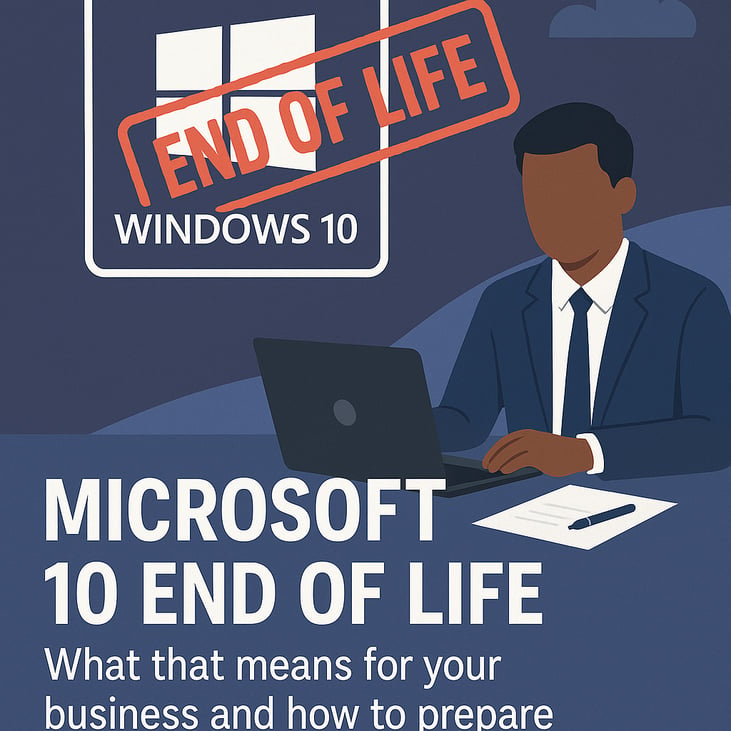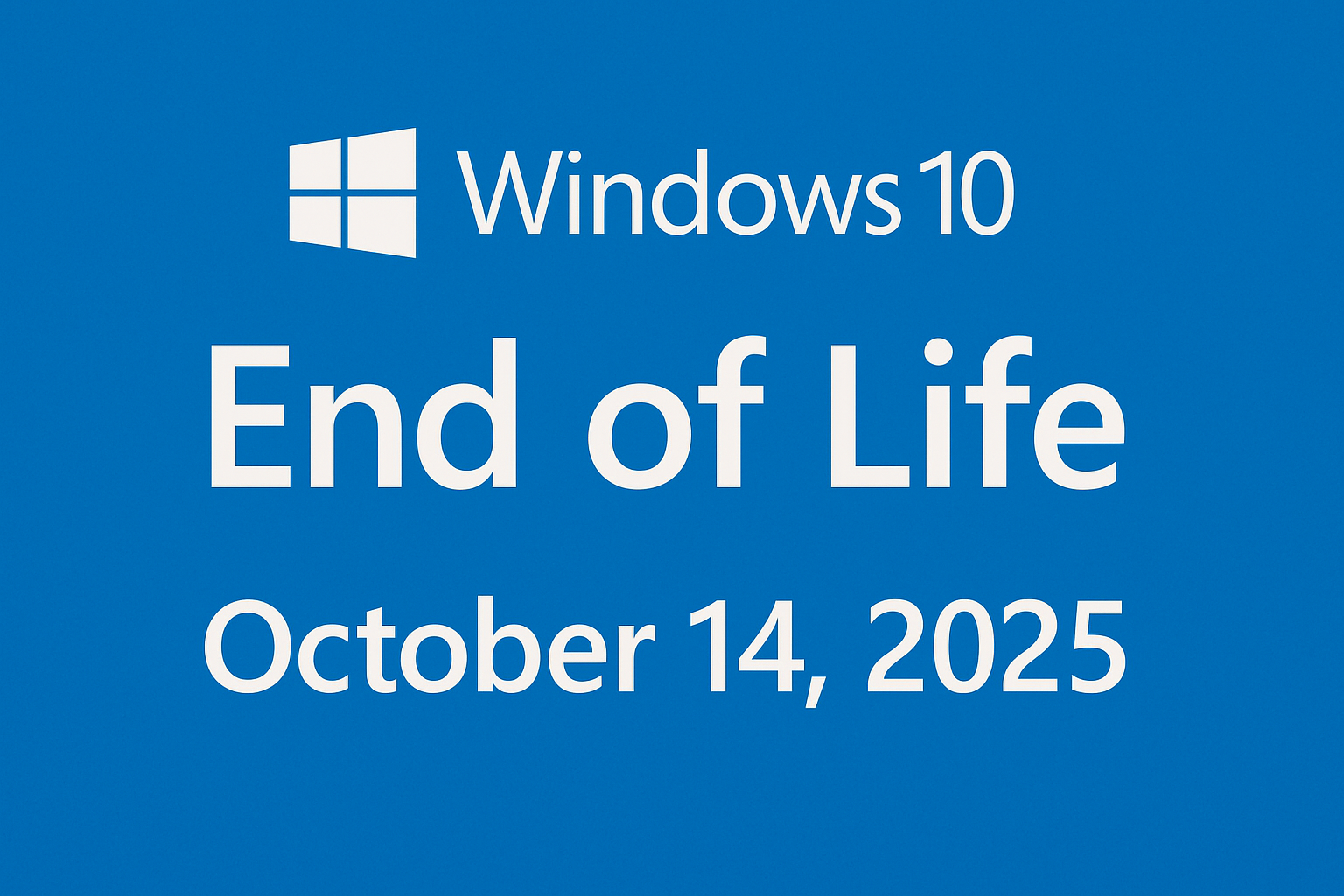
Understanding Microsoft 10 End of Life: What does it mean?
Microsoft has officially announced that Windows 10 will reach its End of Life (EOL) on October 14, 2025. This means that after this milestone, Microsoft will no longer provide technical support, software updates, security patches, or vulnerability fixes for any editions of Windows 10. The cessation of support applies to both core operating system functionalities and embedded security features, impacting all devices running Windows 10—from desktops and laptops to industry-specific workstations and operational critical endpoints.
For businesses, this development represents more than just an IT housekeeping item—it is a strategic turning point that will have far-reaching implications for operational resilience, regulatory compliance, and long-term competitiveness. Failing to meet the EOL deadline could result in unprotected systems, increased vulnerability to sophisticated cyber threats, and eventual disruptions across interconnected digital ecosystems. This makes proactive planning, well-coordinated budgeting, and methodical execution of an operating system migration absolutely essential.
Microsoft’s official lifecycle and retirement timeline is clearly defined: security updates and feature enhancements will taper off as the EOL date approaches, culminating in a complete withdrawal of support. In practice, this means organizations should already be assessing their entire IT estate, identifying legacy and at-risk devices, and engaging key stakeholders from finance, technical operations, security, and compliance teams. Early planning enables a staged approach to migration, allowing businesses to make informed decisions on whether to upgrade to Windows 11, modernize hardware, or consider alternative digital infrastructure solutions.
Because support will phase out in stages, businesses that plan ahead will be best positioned to maintain secure environments, minimize disruption, and take advantage of new productivity and security capabilities offered by next-generation platforms. Waiting until the last moment increases the risk of rushed decisions, user downtime, data loss, and budget overruns.
In summary, the EOL for Windows 10 demands a strategic, organization-wide response. Developing a migration roadmap, allocating the appropriate resources, and collaborating with experienced partners will ensure your business moves forward with confidence and continues to run securely and efficiently in the post-Windows 10 era.
Understanding the Implications of Windows 10 EOL
The impending EOL of Windows 10 is not just a technical deadline; it carries significant and far-reaching implications, especially for Small to Mid-size Businesses (SMBs) that face the challenges of limited budgets and resources. Once Microsoft discontinues regular security patches, every system running Windows 10 will be increasingly vulnerable to cyberattacks. Malicious actors actively seek out unsupported operating systems, knowing that any vulnerabilities discovered after EOL will remain unpatched, providing an attractive entry point for ransomware, data breaches, and advanced persistent threats.
The consequences of such exposures extend well beyond IT; a single breach can cascade into lost customer trust, disclosure of sensitive information, business downtime, and costly incident response efforts. For highly regulated industries—such as healthcare, finance, and manufacturing—this heightened vulnerability can also result in severe financial penalties and sanctions due to non-compliance with legal and industry-specific regulations, including HIPAA, PCI DSS, and GDPR. Regulators are increasingly scrutinizing the use of outdated systems, reinforcing the requirement for ongoing patch management and up-to-date software as a baseline compliance expectation.
In addition to cybersecurity threats, businesses that fail to migrate to a supported operating system risk encountering a broad range of operational challenges. Compatibility issues with new software, cloud services, and productivity tools are likely to arise, limiting the ability to adopt digital innovations and hampering collaboration. Over time, even routine tasks and business-critical applications may experience degraded performance or outright failures, which can directly impact productivity and customer service.
For Small and Mid-size businesses in particular, these disruptions can have an outsized impact. Smaller organizations are often leaner, with less redundancy in staffing or IT infrastructure—meaning that downtime, inefficiencies, or lost data can cripple daily operations, disrupt client relationships, and cause a ripple effect throughout the organization, with competitors advancing on modern technology and optimized workflows, failure to act before the October 2025 deadline risks not only immediate security and compliance penalties but also a longer-term erosion of business value and market relevance.
This makes timely, proactive migration planning not just a best practice, but an operational necessity. By addressing the Windows 10 EOL now, SMBs can secure their digital foundation and position themselves to thrive in a rapidly changing business environment.
Risks and Challenges of Ignoring Windows 10 EOL
Ignoring the Windows 10 EOL deadline can expose businesses to a myriad of escalating risks and operational challenges, each with the potential to disrupt daily business activities and inflict lasting damage on organizational resilience. The most immediate and significant risk is the loss of regular security updates and patches from Microsoft, leaving systems vulnerable to vulnerabilities that hackers are quick to exploit. Unsupported operating systems become prime targets for cybercriminals who actively scan global networks for weaknesses, rapidly weaponize new exploits, and launch targeted ransomware or malware attacks designed to bypass outdated defenses.
The absence of ongoing security maintenance renders every device running Windows 10 vulnerable to potential entry points for threat actors. Once breached, organizations face cascading impacts, ranging from the loss or theft of sensitive data and intellectual property to direct financial losses resulting from business interruption or ransom demands. Compounding this threat is the increasing sophistication of cyber-attacks, which today often involve multi-stage intrusions, lateral movement across networks, and attacks on supply chains or third-party software integrations that SMBs commonly rely on.
Beyond the cyber risk, there are major compliance hazards. Many industries, including healthcare, banking, government, and manufacturing, are governed by rigorous regulations such as HIPAA, PCI DSS, GDPR, or NIST standards, all of which require timely updates and adherence to security best practices. Running an unsupported OS can trigger non-compliance, leading to audits, fines, lawsuits, contract violations, and even loss of accreditation or business partnerships. Regulatory authorities are increasingly intolerant of known vulnerabilities and often treat non-migrated legacy systems as a sign of negligent IT governance.
Operationally, ignoring the Windows 10 EOL endangers productivity and compromises business continuity. Outdated systems are increasingly incompatible with new software, cloud services, and line-of-business applications. Vendors and partners may cease supporting or integrating with legacy platforms, leading to disruptions in workflows and collaboration. Critical business processes—from payroll to inventory management to customer engagement—can become unreliable or stop altogether, resulting in costly outages and reputational harm.
Moreover, support from IT vendors, managed service providers, and software partners is becoming increasingly scarce, as the industry shifts its focus and resources toward modern systems. This results in slower issue resolution, higher costs for custom support, and a growing dependency on internal staff who may lack the expertise or time to address escalating issues. Ultimately, delaying migration past the EOL deadline compounds technical debt, increases exposure to emerging risks, and erodes competitive advantage. Proactive planning and early action are essential—failing to do so places businesses at risk of falling behind technologically and jeopardizes their ability to operate with confidence in an era where digital resilience and compliance are business-critical imperatives.
5-Step Migration Plan for a Seamless Transition
To ensure a smooth transition from Windows 10 to a more current operating system, businesses should follow a comprehensive 5-step migration plan:
1. Audit Your Current Systems: Conduct a thorough audit of all devices and software currently running Windows 10. Identify which systems need upgrading and which can be retired or replaced.
2. Budget for Upgrades: Allocate the necessary budget for purchasing new licenses, hardware, and any additional resources required for the migration.
3. Select Your Migration Path: Decide whether you will upgrade to Windows 11 or another operating system. Consider compatibility, user training, and long-term support in your decision.
4. Develop a Detailed Migration Plan: Create a detailed timeline and action plan for the migration. This should include backup procedures, testing phases, and a roll-back plan in case of issues.
5. Implement and Monitor: Execute the migration plan, ensuring continuous monitoring and support throughout the process. Post-migration, conduct audits to ensure all systems are operating correctly and securely.
How to Prepare Your Team for the Change
Preparing your team for the transition to a new operating system is crucial for minimizing disruption, ensuring business continuity, and maximizing the return on your technology investment. The human element in any IT migration is often the most variable and potentially impactful factor—successful adoption hinges not just on technical execution, but on employee readiness, confidence, and support throughout the process.
Start by communicating the upcoming changes well in advance, providing clarity about the reasons for the migration, the timeline, and the business benefits. Transparent communication helps build trust and sets appropriate expectations, while minimizing uncertainty or resistance. Organize a kickoff meeting or company-wide announcement, and follow up with regular updates as the project progresses to keep everyone informed and engaged.
Provide training sessions and practical resources tailored to different user groups and roles within your organization. Develop step-by-step guides, video tutorials, and live webinars to help employees become familiar with the new interface, features, and workflows of the upgraded system. Consider creating a central knowledge hub or intranet page where team members can access documentation, FAQs, and troubleshooting tips at any time.
Encourage feedback, questions, and open dialogue from your team by establishing clear communication channels—such as dedicated email addresses, chat groups, or internal forums. Actively solicit input on perceived challenges, usability concerns, or training needs, and address these promptly to demonstrate responsiveness. This proactive approach helps mitigate resistance to change and uncovers potential issues before they escalate.
Additionally, designate internal champions or “super users” from each department, empowering them to act as on-the-ground resources who can assist their colleagues, answer common questions, and relay ongoing feedback to the IT and project management teams. These champions serve as trusted points of contact, fostering peer support and reducing the burden on central IT staff.
Don’t overlook the importance of post-migration follow-up. Schedule refresher sessions, regular check-ins, and satisfaction surveys after go-live to assess adoption health, gather insights, and adjust support resources as needed. Recognize and celebrate team successes—both small and large—along the way to reinforce positive momentum and demonstrate leadership commitment to a smooth, confident transition.
By prioritizing thorough communication, stakeholder engagement, and continuous learning, you not only ensure a smoother technical migration but also build an empowered, adaptable workforce ready to leverage new opportunities and solutions in your evolving IT environment.
Leveraging Expert Assistance for a Smooth Transition
While some businesses may have the internal resources to manage the migration, leveraging expert assistance can provide significant benefits and dramatically reduce risk throughout the transition. IT consultants and managed service providers (MSPs), such as Cyber Advisors, bring specialized expertise honed from years of successfully guiding organizations through complex migrations and infrastructure overhauls. Their deep familiarity with best practices, potential pitfalls, and the nuances of regulatory compliance allows them to anticipate and address issues before they impact operations.
These experts deliver end-to-end support for every stage of the migration—beginning with a holistic assessment of your IT environment to identify legacy assets, hidden dependencies, and areas where modernization can yield the greatest ROI. They help you develop a phased migration roadmap designed to minimize disruptions by sequencing upgrades for critical business functions, coordinating downtime windows, and orchestrating testing and validation procedures to ensure seamless cutovers.
Throughout the implementation phase, experienced MSPs manage technical processes such as device imaging, data migration, application reinstallation, integration of security controls, and user access provisioning. With cybersecurity top of mind, they verify that patches, endpoint protections, and secure configurations are in place before, during, and after migration, thereby mitigating new vulnerabilities that can arise during transitional periods.
Post-migration, these partners provide ongoing monitoring, troubleshooting, and user support—ensuring that business continuity is maintained, systems are performing optimally, and end-users have the necessary resources to rapidly adapt. By documenting every step and providing transparent reporting, they empower your leadership team with visibility into project progress and outcomes.
Above all, IT consultants and MSPs serve as trusted advisors. Their perspective, gained from hands-on experience across a range of industries and regulatory frameworks, can help your organization quickly resolve bottlenecks, avoid costly mistakes, and adapt to post-migration technology needs. With their support, even organizations with small or overstretched IT teams can achieve a secure, efficient, and future-proof transition out of Windows 10—and confidently position their business for continued growth and innovation.
Cyber Advisors Has The Experience and Expertise to Guide You Through Windows 10 EOL and Beyond
At Cyber Advisors, we understand the complexities and challenges associated with operating system migrations—especially during critical milestones such as Windows 10 End of Life. Our team brings decades of experience and proven methodologies to ensure your organization's journey from legacy systems to modern, secure platforms is efficient, worry-free, and strategically aligned with your unique business needs.
Our migration process starts with a comprehensive EOL assessment, where we examine your existing IT assets, analyze integration points, and identify legacy dependencies. We go beyond simple inventories to assess risk levels, compliance status, and future-readiness. By working closely with your key stakeholders in IT, compliance, and business management, we develop a migration roadmap that addresses your goals, timelines, and industry regulations.
As part of our comprehensive services, we conduct detailed system audits to identify vulnerabilities and performance gaps, provide accurate budget planning to avoid last-minute surprises, and develop a tailored migration strategy that minimizes downtime and business disruption. Our experts coordinate upgrade scheduling, end-user communication, and backup management to ensure seamless cutovers and real-time continuity of operations.
During implementation, our certified engineers apply advanced best practices for imaging, application deployment, user profile migration, and endpoint hardening—ensuring every device is protected before, during, and after the switch. We incorporate layered security, patch management, and endpoint detection aligned with regulatory requirements, so your environment is not only up-to-date but also resilient against present and future cyber threats.
Beyond technical execution, Cyber Advisors believes in providing true partnership: we offer proactive support throughout the transition and ongoing monitoring and optimization services post-migration. We resolve user issues rapidly, document outcomes, and empower your in-house teams with training, knowledge transfer, and actionable recommendations for ongoing IT improvement.
Our end goal is clear: deliver a seamless and efficient migration that supports your long-term business vision, preserves regulatory compliance, and unlocks the productivity benefits of modern IT. With Cyber Advisors by your side, your organization can confidently navigate Windows 10 EOL—and any future IT transition—with security, efficiency, and peace of mind.
Don’t wait until it’s too late. Contact us today for a free Microsoft 10 upgrade readiness assessment.
The clock is ticking towards the Windows 10 EOL deadline. Don't wait until it's too late to start planning your migration. Contact Cyber Advisors today for a free Microsoft 10 upgrade readiness assessment.
Our team of experts is ready to help you evaluate your current systems, develop a tailored migration plan, and ensure a smooth transition to a supported operating system. Secure your business’s future and avoid the risks associated with unsupported software by contacting us today.



